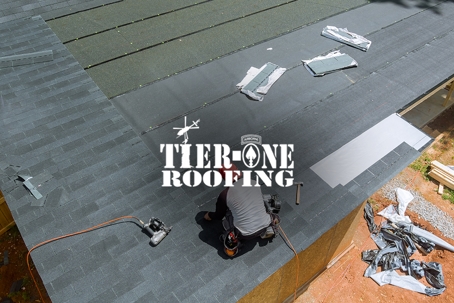Why the Smallest Roof Leak Always Becomes the Biggest Repair
It’s just a drip, right? A little water spot on the ceiling. Something you can “keep an eye on.” But here’s the truth: there’s no such thing as a harmless roof leak. Even the smallest leak can spiral into major damage faster than most homeowners realize. At Tier-One Roofing, we’ve seen leaks the size of a pencil eraser turn into $10,000 repairs simply because they were left untreated.
Here’s why small leaks are big problems and what you should do the moment you see one.
Why Small Leaks Do Big Damage
1. Water Always Spreads
Water doesn’t stay where it drips. It travels along rafters, beams, insulation, and wiring, spreading moisture far from the original leak point. What looks like a single drip could be soaking half your attic.
2. Mold Starts Fast
Mold can start growing in as little as 24–48 hours. A small leak left unchecked quickly becomes a health hazard that costs thousands to remediate.
3. Structural Damage Happens Quietly
Moisture weakens wood decking, rots rafters, and corrodes metal fasteners. By the time you notice sagging or soft spots, you’re looking at a major structural repair.
4. Insulation Loses Effectiveness
Wet insulation compresses and loses its R-value, which means your energy bills climb while your home becomes less comfortable.
Tier-One Roofing addresses the root cause fast to prevent these expensive chain reactions.
Why Leaks Often Go Unnoticed
Hidden Entry Points: Water can enter through flashing, vents, or shingles but show up far from the source.
Seasonal Ignorance: A leak that drips in heavy rain may dry up in summer, tricking homeowners into thinking it’s gone.
Ceiling Spots as First Sign: By the time you see a ceiling stain, water has likely been leaking for weeks or months.
This is why proactive roof inspections are so critical.
Real Homeowner Story: The $200 Leak That Became $8,000
A homeowner noticed a faint brown spot in their guest bedroom. They decided to “watch it” instead of calling for help. Months later, a storm ripped up shingles in the same area, and water poured in. By then, insulation and drywall had to be replaced, electrical systems checked for safety, and part of the roof decking replaced.
Cost difference: $200 for an early flashing repair vs. $8,000 for full structural repairs and water remediation.
Common Sources of Small Leaks
Damaged or Missing Shingles: Even one missing shingle can let water in.
Flashing Failure: Around chimneys, skylights, or vents.
Clogged Gutters: Overflowing water finds its way under shingles.
Nail Pops: Small gaps created by backing-out nails.
Aging Sealants: Cracked seals around penetrations.
Tier-One Roofing inspects all these areas during every service call because one weak point is all it takes.
Insurance and Leak Damage
Here’s another reason small leaks become expensive: insurance companies sometimes deny claims if they determine the damage was due to “neglect.” A small leak you ignored for months might not be covered, leaving you with a full out-of-pocket repair.
We document all findings during our inspections to support your insurance claim and prove you acted quickly.
Why DIY Fixes Usually Fail
Grabbing a tube of caulk or some roofing cement might seem like an easy fix. But without identifying the real source, you’re only covering symptoms. In many cases, DIY fixes trap moisture, accelerate damage, or void warranties.
Tier-One Roofing uses professional leak detection methods, including thermal imaging when necessary, to ensure the fix is permanent.
How Tier-One Roofing Stops Leaks for Good
Immediate Response: We stop active leaks quickly with emergency tarping if needed.
Root Cause Analysis: We find exactly where water is entering, not just where it’s dripping.
Long-Term Repair: Proper flashing, shingle replacement, and underlayment repair for permanent results.
Preventative Advice: We identify potential weak spots so you avoid future leaks.
Your Next Step
If you see a ceiling stain, hear dripping, or even suspect a leak, don’t wait.
Call Tier-One Roofing today for a free inspection. We’ll find the source, stop the damage, and give you a clear, honest plan for repairs.
Because a leak never stays small—and the best way to save money is to act fast.

